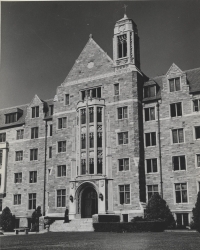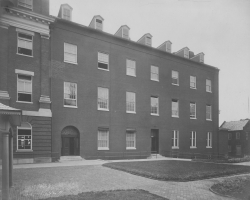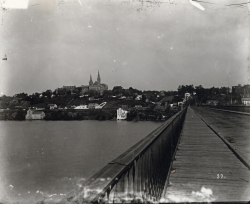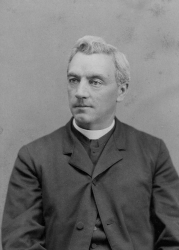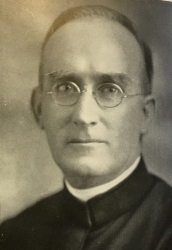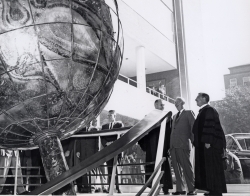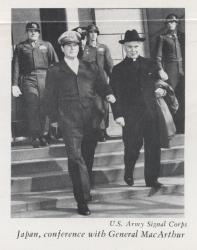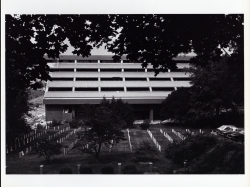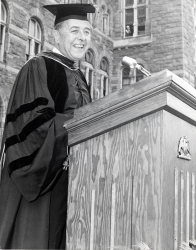Georgetown’s Jesuit heritage may be read in the names of many buildings on campus. In fact, it was not until 1893 and the dedication of Dahlgren Chapel that one of our buildings was named for a non-Jesuit. The 16th-century founder of the Society of Jesus and the Society’s greatest missionary are honored by Loyola and Xavier Halls and five 17th-century Jesuits lend their names to buildings.
The White-Gravenor Building is named for Andrew White, S.J., and John Gravenor, S.J., who came to Maryland in 1634 with the first English settlers, while Gervase Hall recalls Thomas Gervase, S.J., who also traveled with the Ark and the Dove. Copley Hall is the namesake of Thomas Copley, S.J., who embarked for Maryland in 1637 and hoped to found a college as early as 1640 and Poulton Hall carries the name of Ferdinand Poulton, S.J., who followed Father Copley to Maryland and likewise proposed the foundation of a college.
A number of buildings were named for University presidents. Five men who governed the College in the decades surrounding the Civil War were so commemorated: James Ryder, S.J. (1840-1845 and 1848-1851), who established the Medical School during his second term; Bernard A. Maguire, S.J. (1853-1858 and 1866-1870), who created a separate preparatory department for younger students; and Patrick F. Healy, S.J. (1874-1882), who is often referred to as our second founder; as well as Thomas F. Mulledy, S.J. (1829-1837 and 1845-1848) and William McSherry, S.J. (1838-1839), whose names were removed from campus buildings in 2015 in response to a recommendation from the President's Working Group on Slavery, Memory, and Reconciliation. The recommendation came because of their roles in the 1838 sale of the 272 enslaved persons held by the Maryland Jesuits.
Other building names tell of Jesuits who have shaped our more recent history. They tell of presidents, such as W. Coleman Nevils, S.J. (1928-1935), who changed the face of campus with an ambitious building program - Copley, White-Gravenor and the Medical-Dental Building were constructed during his presidency, Lawrence C. Gorman, S.J. (1942-1949), who supervised the construction of the Georgetown University Hospital, Edmund B. Bunn, S.J. (1952-1964), who also served as Chancellor from 1964 until his death in 1972, and Robert J. Henle, S.J. (1969-1976), who restored financial stability during his term and oversaw the introduction of women into the College and the recruitment of a more diverse faculty and students. And building names evoke others appreciated for their contributions to the Georgetown community, like Vincent S. McDonough, S.J., Director of Athletics between 1916 and 1928, Edmund A. Walsh, S.J., who organized the School of Foreign Service in 1919 to promote international peace through education, and Gerard F. Yates, S.J., who spent more than half his life on campus, as a teacher, as Graduate School Dean, as originator of what is now the Office of International Programs, and as a member of the Chimes which he joined in 1953. And with the opening of Leo’s, named for Leo J. O’Donovan, S.J., president from 1989 to 2001, the tradition continues.
This exhibition highlights seven of the campus buildings that were named for Jesuits. Note: This exhibition was updated in 2015 after the recommendations from the President's Working Group on Slavery, Memory, and Reconciliation that Mulledy Hall and McSherry Hall be renamed because of Father Thomas Mulledy and Father William McSherry’s roles in the 1838 sale of the 272 enslaved persons held by the Maryland Jesuits.
White-Gravenor Building, Named for Andrew White, S.J. (1579-1656) and John Gravenor, S.J. (1589-1640)
Both the White-Gravenor Building and Copley Hall have been described as “sermons in stone” because of the Catholic and Jesuit symbolism of their external architectural details. The three story oriel over White-Gravenor’s main entrance includes carved symbols representing academic subjects. The symbol for each subject is accompanied by the name of a Jesuit educator prominent in that field. For example, Suarez, with the lamp of learning, represents Philosophy and Kircher, with lab instruments, represents Science. Directly above the entrance are five shields symbolizing academies founded by the Jesuits in Maryland. These read: 1634 St. Mary’s City; 1640 Calverton Manor; 1677 Newtown Manor; 1745 Bohemia Manor; and 1789 Georgetown Heights.
Copley Hall, Named for Thomas Copley, S.J. (ca. 1595-1652). Pictured in 1955
Among Copley Hall’s many external decorations is a large Latin inscription on its middle gable which reads: Moribus Antiquis Res Stat Loyolaea Virisque. This has been translated as: Loyola’s Fortune Still May Hope To Thrive, If Men and Mold Like Those of Old Survive. The south gable bears the family crest of St. Ignatius Loyola who founded the Society of Jesus, the lily of the seal of the University of Paris where he was educated, and the seal of the Society of Jesus.
Mulledy Hall, now known as Freedom Hall. Originally named for Thomas F. Mulledy, S.J. (1794-1860)
Built as a multi-purpose structure, Mulledy Hall was completed in July 1833. Its first floor served as a student dining hall until 1904, the College Chapel was housed on the second floor until the opening of Dahlgren Chapel in 1893, and the third floor contained an auditorium capable of accommodating more than 1,000 people.
On the morning of February 27, 1947, a three-alarm fire swept through the upper floors of the building. A firefighter broke his leg while fighting the blaze but that, according to accounts in The Hoya, was the only fire-related injury. Edmund A. Walsh, S.J., Regent of the Foreign Service School, returned to the burning building to rescue a large number of photostatic copies of Nuremberg trial documents. These were used in the writing of his book, Total Power: A Footnote To History, published in 1949. The building was subsequently repaired and the fourth floor and roof were rebuilt, although to a different configuration.
Note: This exhibition was updated in 2015 after the recommendation from the President's Working Group on Slavery, Memory, and Reconciliation that Mulledy Hall be renamed because of Father Mulledy's role in the 1838 sale of the 272 enslaved persons held by the Maryland Jesuits.
Thomas F. Mulledy, S.J., President, 1829 to 1837 and 1845 to 1848
When Father Mulledy became president, Georgetown was in decline. However, he proved to be an effective promoter of the College and rapidly increased enrollment. Congressmen and senators became regular visitors and Andrew Jackson, in his first year in the White House, enrolled his ward.
This exhibition was updated in 2015 after the recommendation from the President's Working Group on Slavery, Memory, and Reconciliation that Mulledy Hall be renamed because of Father Mulledy's role in the 1838 sale of the 272 enslaved persons held by Maryland Jesuits.
Healy Hall, dominating the Georgetown skyline, as seen from the Aqueduct Bridge, 1889. Named for Patrick F. Healy, S.J. (1834-1910)
Work began on Healy Hall in late 1877. It was to have space for laboratories and a new library, as well as classrooms, dormitory rooms, and a meeting area for alumni. The firm of J.L. Smithmeyer & Company, who also designed the main building of the Library of Congress, drew up the plans. Their product, massive in scale, is 312 feet long and 95 feet wide with a clock tower that rises 200 feet. With Healy Hall’s opening, the University doubled the total square footage of its buildings.
Healy Hall was the first of our buildings to face the city rather than the river and it has been suggested that Father Healy deliberately oriented it as a signal that Georgetown should be viewed, from that point on, as an educational institution of national importance.
Patrick F. Healy, S.J., President, 1874-1882
Patrick F. Healy, S.J., one of the University’s most dynamic presidents, is credited with changing Georgetown from a small liberal arts college into a modern university. In addition to raising funds for Healy Hall and overseeing its construction, he undertook to expand our curriculum, to implement more strenuous graduation requirements, to improve the professional schools, and to increase studies in science. Born in Georgia in 1834, Father Healy was the son of Michael Morris Healy, an Irish immigrant, and his wife, Mary Eliza, a former slave. He entered the Jesuit Order in 1850 and became the first African-American to earn a Ph.D. and the first to head a predominantly white university.
McDonough Memorial Gym. Groundbreaking ceremony, May 20, 1950. Named for Vincent S. McDonough, S.J. (1870-1939)
By the late 1940's, there was a pressing need on campus for a new gymnasium to replace the outdated facilities in Ryan Gym. The original plans placed the new gym next to the old but that concept was eventually dropped because of noise, parking, and access issues and an alternative site, south of the Observatory, was selected. The McDonough Memorial Gym was entirely funded by subscriptions from alumni and friends and the dedication ceremonies in December 1951 attracted over 1,000 alumni, the largest gathering of alumni at Georgetown to that point.
Vincent S. McDonough, S.J. Director of Athletics, 1916 to 1928
Father “Mac” was both revered and feared by students. In addition to serving as Director of Athletics, he was also Prefect of Discipline and a student counselor. When asked what he would most like to honor his 25th anniversary as a priest, he replied, “You give the boys a new gym and I’ll be happy.” A few days later, on September 3, 1939, he was found dead in his room, beside a radio broadcasting news of the declarations of war by Britain and France. Lou Little, who coached under Father “Mac”, said of him, “I never knew a man with so broad a vision. I never knew one who understood boys as he understood them. I never saw him confronted with a decision and fail to give a fair and sympathetic answer- one that satisfied all hands and endeared him to all.”
Walsh Memorial Building. Dedication ceremony, October 13, 1958. Named for Edmund A. Walsh, S.J. (1885-1956)
The Walsh Building, dedicated by President Dwight D. Eisenhower, was built for the School of Foreign Service. Among the modern and much touted features of the new building were air conditioning and a public address system. The showplace of the building was the Hall of Nations, an auditorium capable of seating over 500, which contained the flags of sixty countries and the seal of the United Nations on the rostrum. The plexiglas globe of the world in the lobby, ten feet in diameter, rotated once every three minutes. It was, at the time of the building’s opening, the largest rotating globe in the world.
Edmund A. Walsh, S.J., photographed with General Douglas MacArthur in Tokyo, 1948
Priest, educator, scholar, and statesman, Father Walsh established the School of Foreign Service in 1919, the first of its kind in the U.S. While remaining actively involved in the running of the School, he undertook many international trips and diplomatic missions. He directed the Papal Famine Relief Mission to Russia in 1922, worked on behalf of the Vatican to resolve long-standing issues between Church and State in Mexico in 1929, negotiated with the Iraqi government to establish an American College in Baghdad in 1931, and served as Consultant to the U.S. Chief of Counsel at the Nuremberg Trials.
President Eisenhower sent a letter to the University when Father Walsh died, which read in part, “The death of Father Walsh is a grievous loss to the Society in which he served so many years, to the educational and religious life of the United States and to the free people of the Western World. For four decades, he was a vigorous and inspiring champion of freedom for mankind and independence for nations . . . at every call to duty, all his energy of leadership and wisdom of counsel were devoted to the service of the United States.”
Bunn Intercultural Center, with the Jesuit Community cemetery in the foreground, photographed in 1982. Named for Edmund B. Bunn, S.J. (1896-1972)
By the mid-1970's, Georgetown’s international programs and activities had outgrown the physical capacity of the University to house them, so planning began for a new building which could consolidate all main campus international programs and contributing departments in one building. The project was given impetus, and federal funding, by a national recognition of the need for intercultural education and the Intercultural Center was dedicated in 1982. A quotation from French priest and paleontologist, Pierre Teilhard de Chardin, S.J., appears above the stairs leading down to its auditorium: The Age of Nations is past. It remains for us now, if we do not wish to perish, to set aside the ancient prejudices and build the earth.
Edmund B. Bunn, S.J., President, 1952-1964, Chancellor, 1964-1972
Father Bunn, known as “Doc” to his friends, reorganized and consolidated University administration during his tenure. He also developed study aboard programs and oversaw the construction of eight buildings in ten years. When talking to students, he often stressed the five “C’s” he felt they should have: courtesy, cooperation, consideration, challenge and commitment. In 1952, he said, “A mediocre thing is not worth a man’s whole life - unless you are willing to strive, to work, to sacrifice for the highest and best possible, it would be better to resign . . . and get into something else, where half-hearted effort and mediocre achievement are less damaging and less important, than the field of education. But, for myself, I will never give consideration to anything but the best.”


